Liang Zhou
Tony
Ensemble Visualization With Variational Autoencoder
Sep 16, 2025Abstract:We present a new method to visualize data ensembles by constructing structured probabilistic representations in latent spaces, i.e., lower-dimensional representations of spatial data features. Our approach transforms the spatial features of an ensemble into a latent space through feature space conversion and unsupervised learning using a variational autoencoder (VAE). The resulting latent spaces follow multivariate standard Gaussian distributions, enabling analytical computation of confidence intervals and density estimation of the probabilistic distribution that generates the data ensemble. Preliminary results on a weather forecasting ensemble demonstrate the effectiveness and versatility of our method.
Attonsecond Streaking Phase Retrieval Via Deep Learning Methods
May 06, 2025Abstract:Attosecond streaking phase retrieval is essential for resolving electron dynamics on sub-femtosecond time scales yet traditional algorithms rely on iterative minimization and central momentum approximations that degrade accuracy for broadband pulses. In this work phase retrieval is reformulated as a supervised computer-vision problem and four neural architectures are systematically compared. A convolutional network demonstrates strong sensitivity to local streak edges but lacks global context; a vision transformer captures long-range delay-energy correlations at the expense of local inductive bias; a hybrid CNN-ViT model unites local feature extraction and full-graph attention; and a capsule network further enforces spatial pose agreement through dynamic routing. A theoretical analysis introduces local, global and positional sensitivity measures and derives surrogate error bounds that predict the strict ordering $CNN<ViT<Hybrid<Capsule$. Controlled experiments on synthetic streaking spectrograms confirm this hierarchy, with the capsule network achieving the highest retrieval fidelity. Looking forward, embedding the strong-field integral into physics-informed neural networks and exploring photonic hardware implementations promise pathways toward real-time attosecond pulse characterization under demanding experimental conditions.
GPT-4o System Card
Oct 25, 2024Abstract:GPT-4o is an autoregressive omni model that accepts as input any combination of text, audio, image, and video, and generates any combination of text, audio, and image outputs. It's trained end-to-end across text, vision, and audio, meaning all inputs and outputs are processed by the same neural network. GPT-4o can respond to audio inputs in as little as 232 milliseconds, with an average of 320 milliseconds, which is similar to human response time in conversation. It matches GPT-4 Turbo performance on text in English and code, with significant improvement on text in non-English languages, while also being much faster and 50\% cheaper in the API. GPT-4o is especially better at vision and audio understanding compared to existing models. In line with our commitment to building AI safely and consistent with our voluntary commitments to the White House, we are sharing the GPT-4o System Card, which includes our Preparedness Framework evaluations. In this System Card, we provide a detailed look at GPT-4o's capabilities, limitations, and safety evaluations across multiple categories, focusing on speech-to-speech while also evaluating text and image capabilities, and measures we've implemented to ensure the model is safe and aligned. We also include third-party assessments on dangerous capabilities, as well as discussion of potential societal impacts of GPT-4o's text and vision capabilities.
Visual Analysis of Multi-outcome Causal Graphs
Jul 31, 2024Abstract:We introduce a visual analysis method for multiple causal graphs with different outcome variables, namely, multi-outcome causal graphs. Multi-outcome causal graphs are important in healthcare for understanding multimorbidity and comorbidity. To support the visual analysis, we collaborated with medical experts to devise two comparative visualization techniques at different stages of the analysis process. First, a progressive visualization method is proposed for comparing multiple state-of-the-art causal discovery algorithms. The method can handle mixed-type datasets comprising both continuous and categorical variables and assist in the creation of a fine-tuned causal graph of a single outcome. Second, a comparative graph layout technique and specialized visual encodings are devised for the quick comparison of multiple causal graphs. In our visual analysis approach, analysts start by building individual causal graphs for each outcome variable, and then, multi-outcome causal graphs are generated and visualized with our comparative technique for analyzing differences and commonalities of these causal graphs. Evaluation includes quantitative measurements on benchmark datasets, a case study with a medical expert, and expert user studies with real-world health research data.
A Plug-and-Play Untrained Neural Network for Full Waveform Inversion in Reconstructing Sound Speed Images of Ultrasound Computed Tomography
Jun 14, 2024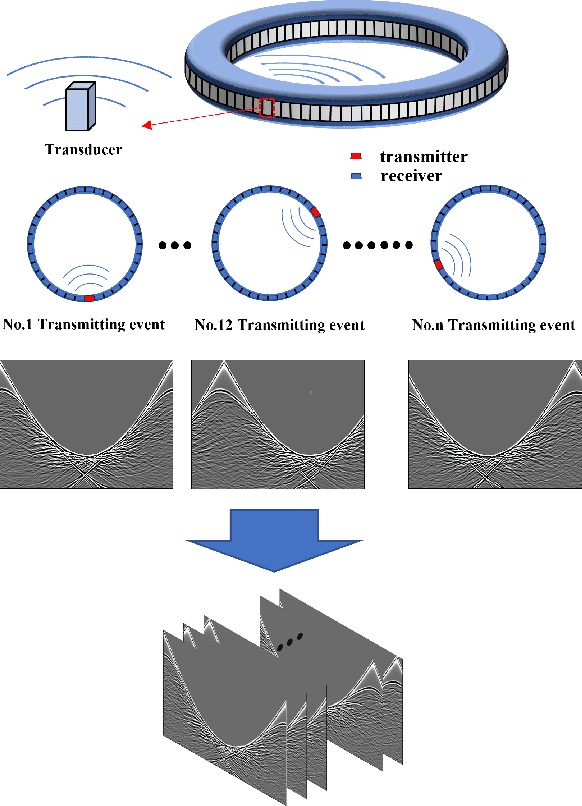
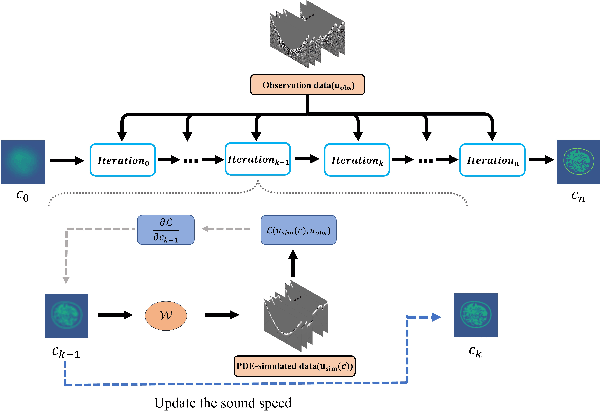
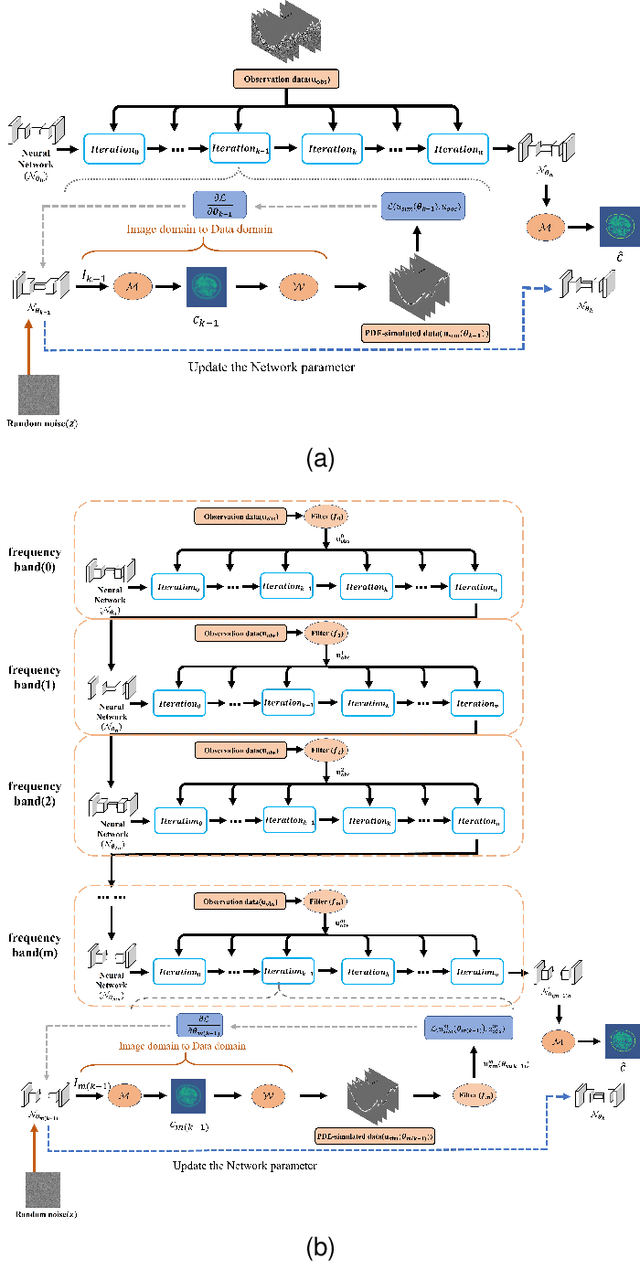
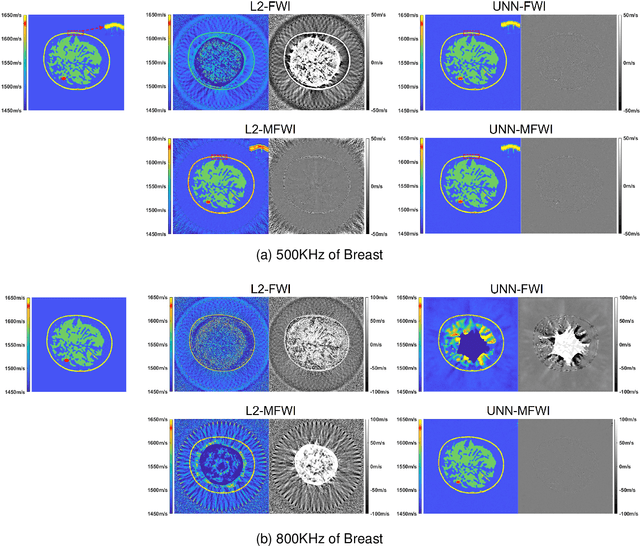
Abstract:Ultrasound computed tomography (USCT), as an emerging technology, can provide multiple quantitative parametric images of human tissue, such as sound speed and attenuation images, distinguishing it from conventional B-mode (reflection) ultrasound imaging. Full waveform inversion (FWI) is acknowledged as a technique with the greatest potential for reconstructing high-resolution sound speed images in USCT. However, traditional FWI for sound speed image reconstruction suffers from high sensitivity to the initial model caused by its strong non-convex nonlinearity, resulting in poor performance when ultrasound signals are at high frequencies. This limitation significantly restricts the application of FWI in the USCT imaging field. In this paper, we propose an untrained neural network (UNN) that can be integrated into the traditional iteration-based FWI framework as an implicit regularization prior. This integration allows for seamless deployment as a plug-and-play module within existing FWI algorithms or their variants. Notably, the proposed UNN method can be trained in an unsupervised fashion, a vital aspect in medical imaging where ground truth data is often unavailable. Evaluations of the numerical simulation and phantom experiment of the breast demonstrate that the proposed UNN improves the robustness of image reconstruction, reduces image artifacts, and achieves great image contrast. To the best of our knowledge, this study represents the first attempt to propose an implicit UNN for FWI in reconstructing sound speed images for USCT.
Adjacent-level Feature Cross-Fusion with 3D CNN for Remote Sensing Image Change Detection
Feb 10, 2023



Abstract:Deep learning-based change detection using remote sensing images has received increasing attention in recent years. However, how to effectively extract and fuse the deep features of bi-temporal images to improve the accuracy of change detection is still a challenge. To address that, a novel adjacent-level feature fusion network with 3D convolution (named AFCF3D-Net) is proposed in this article. First, through the inner fusion property of 3D convolution, we design a new feature fusion way that can simultaneously extract and fuse the feature information from bi-temporal images. Then, in order to bridge the semantic gap between low-level features and high-level features, we propose an adjacent-level feature cross-fusion (AFCF) module to aggregate complementary feature information between the adjacent-levels. Furthermore, the densely skip connection strategy is introduced to improve the capability of pixel-wise prediction and compactness of changed objects in the results. Finally, the proposed AFCF3D-Net has been validated on the three challenging remote sensing change detection datasets: Wuhan building dataset (WHU-CD), LEVIR building dataset (LEVIR-CD), and Sun Yat-Sen University (SYSU-CD). The results of quantitative analysis and qualitative comparison demonstrate that the proposed AFCF3D-Net achieves better performance compared to the other state-of-the-art change detection methods.
Advances and Challenges in Multimodal Remote Sensing Image Registration
Feb 07, 2023Abstract:Over the past few decades, with the rapid development of global aerospace and aerial remote sensing technology, the types of sensors have evolved from the traditional monomodal sensors (e.g., optical sensors) to the new generation of multimodal sensors [e.g., multispectral, hyperspectral, light detection and ranging (LiDAR) and synthetic aperture radar (SAR) sensors]. These advanced devices can dynamically provide various and abundant multimodal remote sensing images with different spatial, temporal, and spectral resolutions according to different application requirements. Since then, it is of great scientific significance to carry out the research of multimodal remote sensing image registration, which is a crucial step for integrating the complementary information among multimodal data and making comprehensive observations and analysis of the Earths surface. In this work, we will present our own contributions to the field of multimodal image registration, summarize the advantages and limitations of existing multimodal image registration methods, and then discuss the remaining challenges and make a forward-looking prospect for the future development of the field.
Implicit Multidimensional Projection of Local Subspaces
Sep 07, 2020


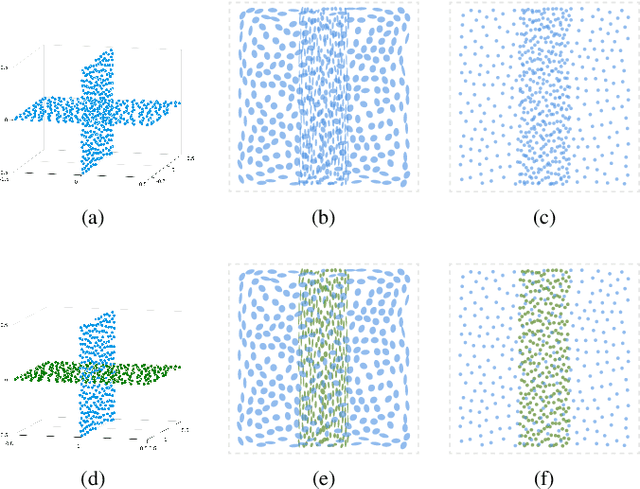
Abstract:We propose a visualization method to understand the effect of multidimensional projection on local subspaces, using implicit function differentiation. Here, we understand the local subspace as the multidimensional local neighborhood of data points. Existing methods focus on the projection of multidimensional data points, and the neighborhood information is ignored. Our method is able to analyze the shape and directional information of the local subspace to gain more insights into the global structure of the data through the perception of local structures. Local subspaces are fitted by multidimensional ellipses that are spanned by basis vectors. An accurate and efficient vector transformation method is proposed based on analytical differentiation of multidimensional projections formulated as implicit functions. The results are visualized as glyphs and analyzed using a full set of specifically-designed interactions supported in our efficient web-based visualization tool. The usefulness of our method is demonstrated using various multi- and high-dimensional benchmark datasets. Our implicit differentiation vector transformation is evaluated through numerical comparisons; the overall method is evaluated through exploration examples and use cases.
Fast and Robust Registration of Aerial Images and LiDAR data Based on Structrual Features and 3D Phase Correlation
Apr 21, 2020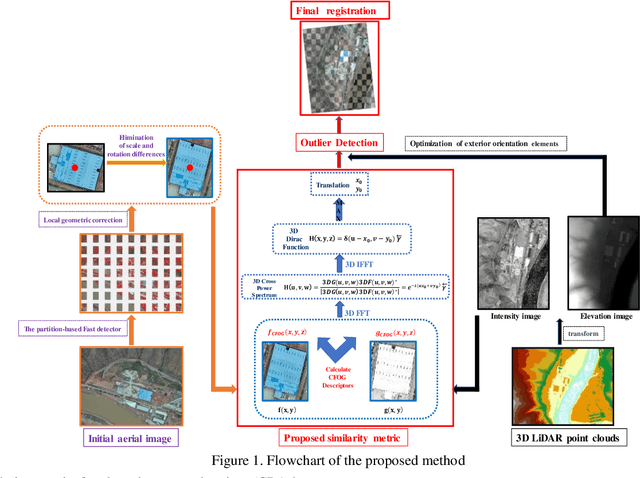
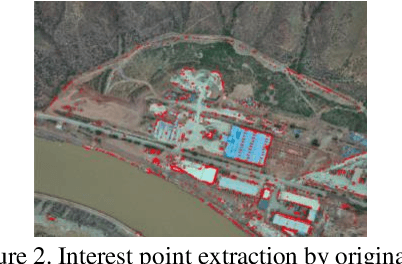
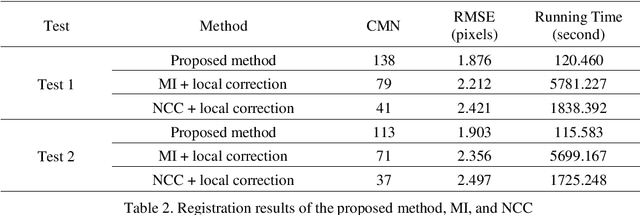
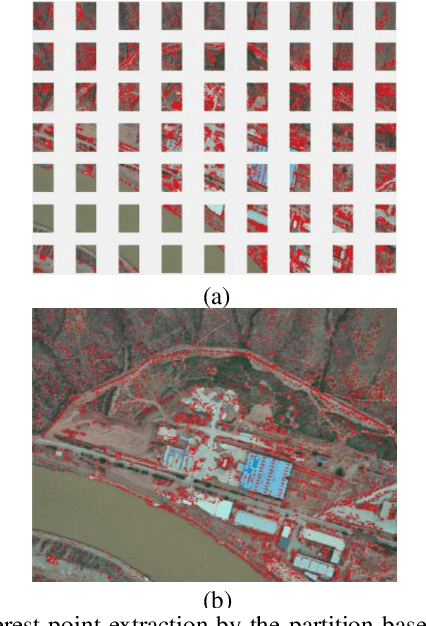
Abstract:Co-Registration of aerial imagery and Light Detection and Ranging (LiDAR) data is quilt challenging because the different imaging mechanism causes significant geometric and radiometric distortions between such data. To tackle the problem, this paper proposes an automatic registration method based on structural features and three-dimension (3D) phase correlation. In the proposed method, the LiDAR point cloud data is first transformed into the intensity map, which is used as the reference image. Then, we employ the Fast operator to extract uniformly distributed interest points in the aerial image by a partition strategy and perform a local geometric correction by using the collinearity equation to eliminate scale and rotation difference between images. Subsequently, a robust structural feature descriptor is build based on dense gradient features, and the 3D phase correlation is used to detect control points (CPs) between aerial images and LiDAR data in the frequency domain, where the image matching is accelerated by the 3D Fast Fourier Transform (FFT). Finally, the obtained CPs are employed to correct the exterior orientation elements, which is used to achieve co-registration of aerial images and LiDAR data. Experiments with two datasets of aerial images and LiDAR data show that the proposed method is much faster and more robust than state of the art methods
KALE: When Energy-Based Learning Meets Adversarial Training
Mar 10, 2020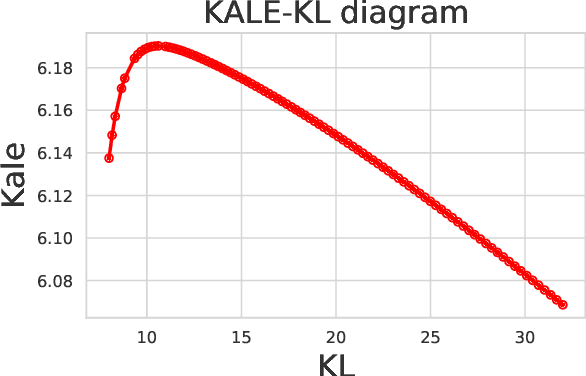

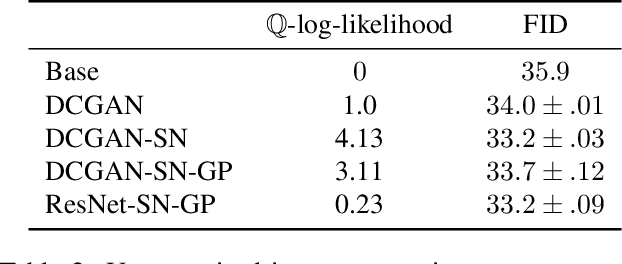
Abstract:Legendre duality provides a variational lower-bound for the Kullback-Leibler divergence (KL) which can be estimated using samples, without explicit knowledge of the density ratio. We use this estimator, the \textit{KL Approximate Lower-bound Estimate} (KALE), in a contrastive setting for learning energy-based models, and show that it provides a maximum likelihood estimate (MLE). We then extend this procedure to adversarial training, where the discriminator represents the energy and the generator is the base measure of the energy-based model. Unlike in standard generative adversarial networks (GANs), the learned model makes use of both generator and discriminator to generate samples. This is achieved using Hamiltonian Monte Carlo in the latent space of the generator, using information from the discriminator, to find regions in that space that produce better quality samples. We also show that, unlike the KL, KALE enjoys smoothness properties that make it suitable for adversarial training, and provide convergence rates for KALE when the negative log density ratio belongs to the variational family. Finally, we demonstrate the effectiveness of this approach on simple datasets.
 Add to Chrome
Add to Chrome Add to Firefox
Add to Firefox Add to Edge
Add to Edge